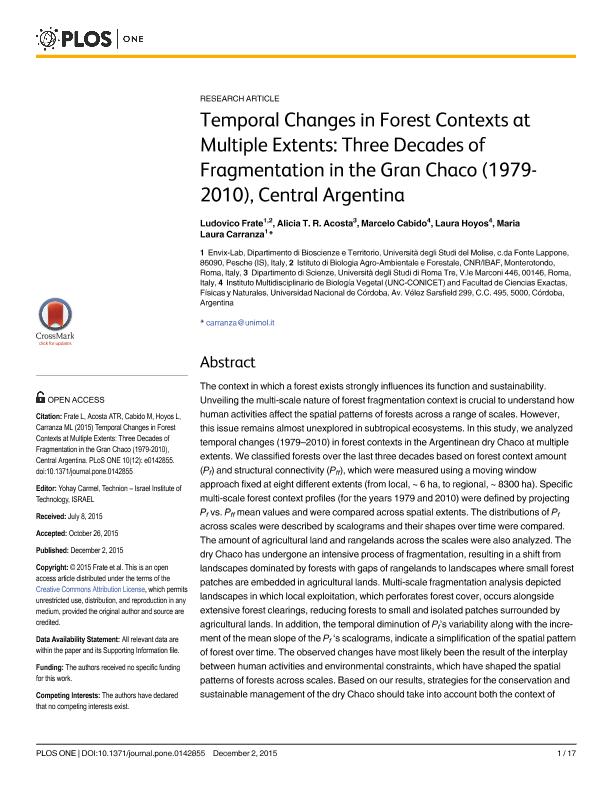Mostrar el registro sencillo del ítem
dc.contributor.author
Frate, Ludovico
dc.contributor.author
Acosta, Alicia T. R.
dc.contributor.author
Cabido, Marcelo Ruben

dc.contributor.author
Hoyos, Laura Emilia

dc.contributor.author
Carranza, Maria Laura
dc.date.available
2018-08-08T18:03:42Z
dc.date.issued
2015-12
dc.identifier.citation
Frate, Ludovico; Acosta, Alicia T. R.; Cabido, Marcelo Ruben; Hoyos, Laura Emilia; Carranza, Maria Laura; Temporal changes in forest contexts at multiple extents: Three decades of fragmentation in the Gran Chaco (1979-2010), Central Argentina; Public Library of Science; Plos One; 10; 12; 12-2015
dc.identifier.issn
1932-6203
dc.identifier.uri
http://hdl.handle.net/11336/54607
dc.description.abstract
The context in which a forest exists strongly influences its function and sustainability. Unveiling the multi-scale nature of forest fragmentation context is crucial to understand how human activities affect the spatial patterns of forests across a range of scales. However, this issue remains almost unexplored in subtropical ecosystems. In this study, we analyzed temporal changes (1979-2010) in forest contexts in the Argentinean dry Chaco at multiple extents. We classified forests over the last three decades based on forest context amount (Pf) and structural connectivity (Pff), which were measured using a moving window approach fixed at eight different extents (from local, ∼ 6 ha, to regional, ∼ 8300 ha). Specific multi-scale forest context profiles (for the years 1979 and 2010) were defined by projecting Pf vs. Pff mean values and were compared across spatial extents. The distributions of Pf across scales were described by scalograms and their shapes over time were compared. The amount of agricultural land and rangelands across the scales were also analyzed. The dry Chaco has undergone an intensive process of fragmentation, resulting in a shift from landscapes dominated by forests with gaps of rangelands to landscapes where small forest patches are embedded in agricultural lands. Multi-scale fragmentation analysis depicted landscapes in which local exploitation, which perforates forest cover, occurs alongside extensive forest clearings, reducing forests to small and isolated patches surrounded by agricultural lands. In addition, the temporal diminution of Pf's variability along with the increment of the mean slope of the Pf's scalograms, indicate a simplification of the spatial pattern of forest over time. The observed changes have most likely been the result of the interplay between human activities and environmental constraints, which have shaped the spatial patterns of forests across scales. Based on our results, strategies for the conservation and sustainable management of the dry Chaco should take into account both the context of each habitat location and the scales over which a forest pattern might be preserved, altered or restored.
dc.format
application/pdf
dc.language.iso
eng
dc.publisher
Public Library of Science

dc.rights
info:eu-repo/semantics/openAccess
dc.rights.uri
https://creativecommons.org/licenses/by-nc-sa/2.5/ar/
dc.subject
Fragmentation
dc.subject
Gran Chaco
dc.subject
Scales
dc.subject
Forest Loss
dc.subject.classification
Otras Ciencias Biológicas

dc.subject.classification
Ciencias Biológicas

dc.subject.classification
CIENCIAS NATURALES Y EXACTAS

dc.title
Temporal changes in forest contexts at multiple extents: Three decades of fragmentation in the Gran Chaco (1979-2010), Central Argentina
dc.type
info:eu-repo/semantics/article
dc.type
info:ar-repo/semantics/artículo
dc.type
info:eu-repo/semantics/publishedVersion
dc.date.updated
2018-07-23T17:40:46Z
dc.journal.volume
10
dc.journal.number
12
dc.journal.pais
Estados Unidos

dc.journal.ciudad
San Francisco
dc.description.fil
Fil: Frate, Ludovico. Università degli Studi del Molise; Italia
dc.description.fil
Fil: Acosta, Alicia T. R.. Università degli Studi di Roma Tre; Italia
dc.description.fil
Fil: Cabido, Marcelo Ruben. Consejo Nacional de Investigaciones Científicas y Técnicas. Centro Científico Tecnológico Conicet - Córdoba. Instituto Multidisciplinario de Biología Vegetal. Universidad Nacional de Córdoba. Facultad de Ciencias Exactas Físicas y Naturales. Instituto Multidisciplinario de Biología Vegetal; Argentina
dc.description.fil
Fil: Hoyos, Laura Emilia. Consejo Nacional de Investigaciones Científicas y Técnicas. Centro Científico Tecnológico Conicet - Córdoba. Instituto Multidisciplinario de Biología Vegetal. Universidad Nacional de Córdoba. Facultad de Ciencias Exactas Físicas y Naturales. Instituto Multidisciplinario de Biología Vegetal; Argentina
dc.description.fil
Fil: Carranza, Maria Laura. Università degli Studi del Molise; Italia
dc.journal.title
Plos One

dc.relation.alternativeid
info:eu-repo/semantics/altIdentifier/doi/https://doi.org/10.1371/journal.pone.0142855
dc.relation.alternativeid
info:eu-repo/semantics/altIdentifier/url/http://journals.plos.org/plosone/article?id=10.1371/journal.pone.0142855
Archivos asociados
